Team-BHP
(
https://www.team-bhp.com/forum/)
- -
Driven: Lexus NX 300h
(
https://www.team-bhp.com/forum/test-drives-initial-ownership-reports/198359-driven-lexus-nx-300h.html)
The
Lexus NX 300h is on sale in India at a price of between Rs. 53.18 - 55.58 lakhs (ex-Delhi).
What you'll like:
• Funky styling stands out from the crowd. Decently priced for a CBU too (
imported as is from Japan)
• Hybrid powertrain with good low-end torque and a butter-smooth CVT gearbox
• Loaded with kit (adaptive suspension, 14-speaker sound, 360° camera, ventilated seats, panoramic roof)
• 5-star NCAP safety rating & equipment
• Lexus' track record of reliability & exemplary customer service
What you won't:
• Many will find the weird styling to be a turnoff (especially that overdone face)
• Awfully limited boot space makes it impractical for long road-trips or airport runs
• Boring to drive; nowhere as much fun as the European competition
• CVT can get lazy & noisy with a heavy right foot
• Tiny sales network. Period
This review has been jointly compiled with blackwasp. Thanks to him for the expert observations & photography!
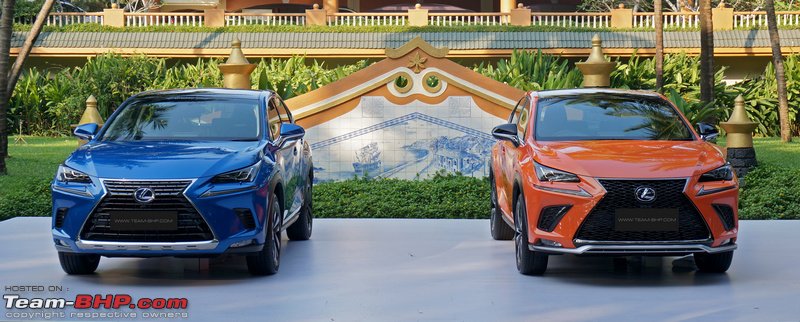
Exterior
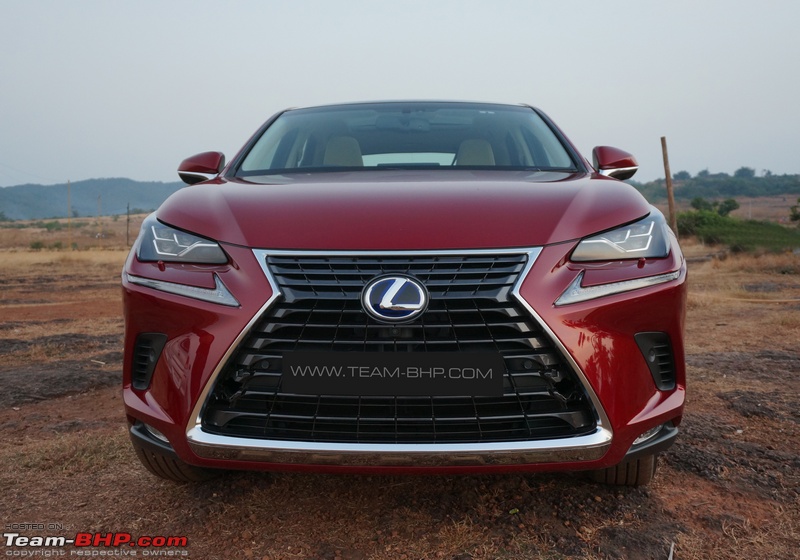
Lexus would have been selling cars in India from as early as 2013 had it not been for the increased import duties causing them to delay their plans. They finally began their Indian operations in early 2017 with the launch of 3 models - The ES 300h, RX 450h and the LX 450d (all overpriced). The swanky showrooms in posh locations along with customer interactions at a more personal level is their strategy at wooing the luxury customer. Competing on pricing is not an option since all the Lexus models are CBU, hence attracting hefty taxes. The NX 300h is the fourth offering from Lexus in India. It's their entry level (if you can even call a 50L SUV that) model that slots below the RX 450h and even below their ES 300h sedan. We must say that the NX is well-priced for a CBU. Looking at the pricing of the ES and RX, the NX was expected to be close to the Rs. 60 lakhs range. Surprisingly Lexus has priced the NX starting at Rs. 53.18 lakhs which is very close to the GLC, Q5 and recently launched X3.
Lexus being the luxury brand of Toyota, should offer the buyer the best of both worlds - Japanese reliability combined with luxury. To further distinguish the NX from the pack, Lexus will offer it with a sole hybrid powertrain. Other countries get a lower spec 2.0 petrol, but the top spec is the 300h hybrid. The same powertrain is seen in the ES 300h as well as the Toyota Camry Hybrid. Hybrids make perfect sense for India as they're built for exactly our driving conditions. The transition to all electric will happen, but with the current infrastructure, the Hybrid solution offers the best of both worlds.
The NX is available in 2 trims, F-Sport and Luxury. The F-Sport gets some sporty styling elements vs the luxury variant, else both variants are equally spec'ed mechanically. The changes in the F-Sport include a different bumper, grill with blackened chrome, F-Sport badges, artificial sound generator in the cabin and a different interior colour scheme.
Toyota's New MC platform underpins the NX 300h. It is based on the Toyota RAV4 (parts of the structure), but the design of the exterior and interior is all Lexus. Nobody will even relate the NX to a Toyota RAV4. The Crossover measures 4,640 mm in length, 1,845 mm in width and 1,645 mm in height. The wheelbase is 2,660 mm with the ground clearance at 185 mm (laden).
Lexus offers a 1,00,000 km / 3 year warranty as standard as well as 3 free services at 1,000 km, 10,000 km and 20,000 km. An additional 50,000 km / 2 year warranty can be taken for the hybrid battery.
Styling on the new Lexus cars is highly polarizing, you'll either love it or hate it. The NX stands out amongst all the other cars on the road with it's sharp lines all over. At the front, there is the large Lexus spindle grille that gets a lot of attention. All Lexus cars now feature this grille and the opinion on this grill is largely divided (most BHPians hate it). This might dissuade buyers looking for subtlety but on the other hand, it could be what a buyer wants to differentiate themselves from the now ubiquitous Audi, BMW and Mercedes front ends:

Compared to the front, the rear looks less in your face. It still has its fair share of sharp cuts and creases:
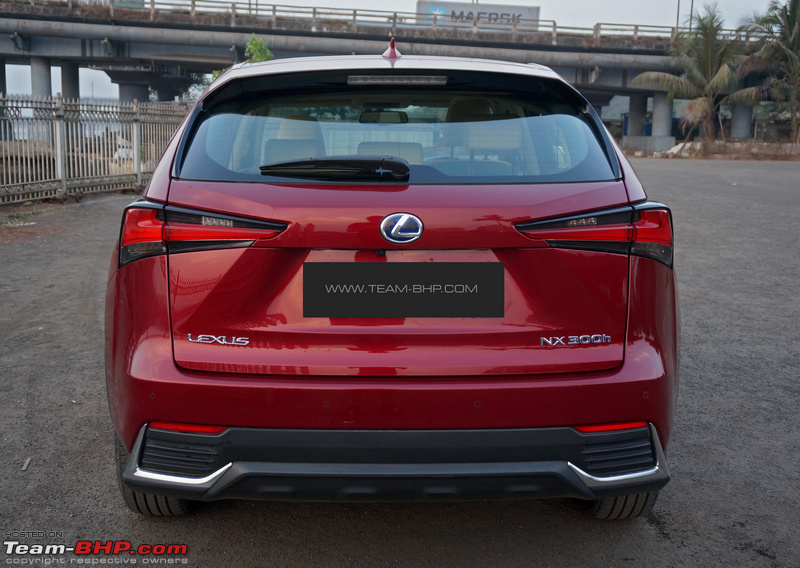
The length stands at 4,640 mm which means it's among the smallest in the segment. It's closest to the Mercedes GLC (4656 mm), while the wheelbase is 2,660 mm which is again the shortest in the segment. The side profile consists of a lot of sharp lines - The dominating shoulder line swoops down and then upwards in the front door, ending near the tail lights. The window line also has a sharp crease at the D pillar. Both wheel arches are swept back. The three creases all meet just above the tail light giving it a very futuristic look:

The NX stands for 'Nimble Crossover'. Fit and finish are perfect and all the panel gaps are tight and highly consistent. Paint quality is top notch. This is expected, considering this is a CBU straight out of Japan. Lexus offers a choice of 12 exterior shades! Not usually the case with manufacturers offering 5 - 7 options:

The car looks bigger than it is from this angle. Notice how the three prominent crease lines culminate at the tail lights:
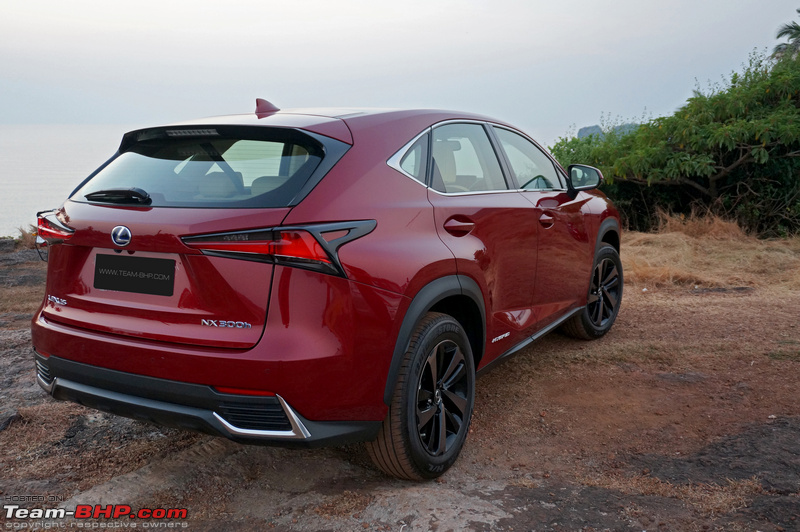
Headlights look damn small. These are tri-beam LED headlights, with the indicator and DRL below. They have a good throw, but their cutoff is on the lower side. High beam is automatic and switches on and off based on oncoming traffic. Basically this means that in India, they will always be on low beam if they are set to "Auto" mode. The lamps low down in the bumper are for cornering & light up based on the steering angle. Front parking sensors are neatly integrated in the grille as well as the side vents:

The headlamp gets brushed aluminium inserts around the LED projectors. The sides get the Lexus name as well as a reflector. A headlamp washer jet is located between the main unit and the DRL strip. Looks odd being a round shape surrounded by sharp lines; should have been concealed better:
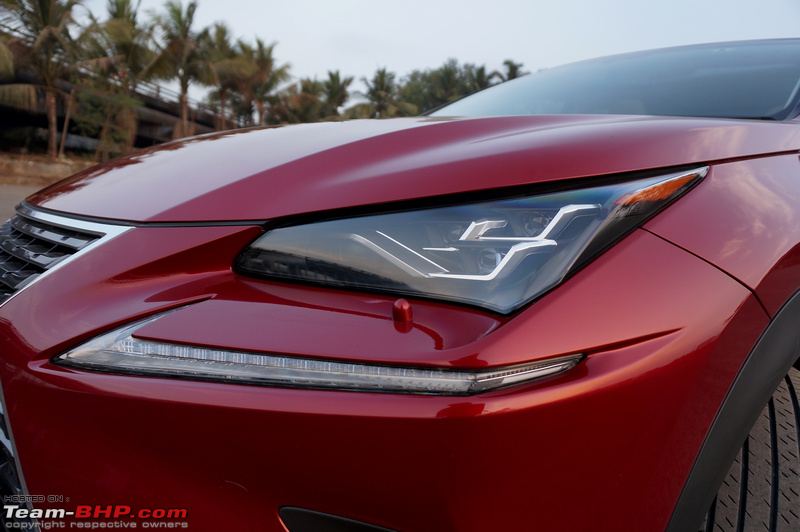
LED DRL along with indicator located below the main headlight cluster. When you turn on the indicator, the DRL turns off as seen below. Also notice the 3 LED beams turned on:
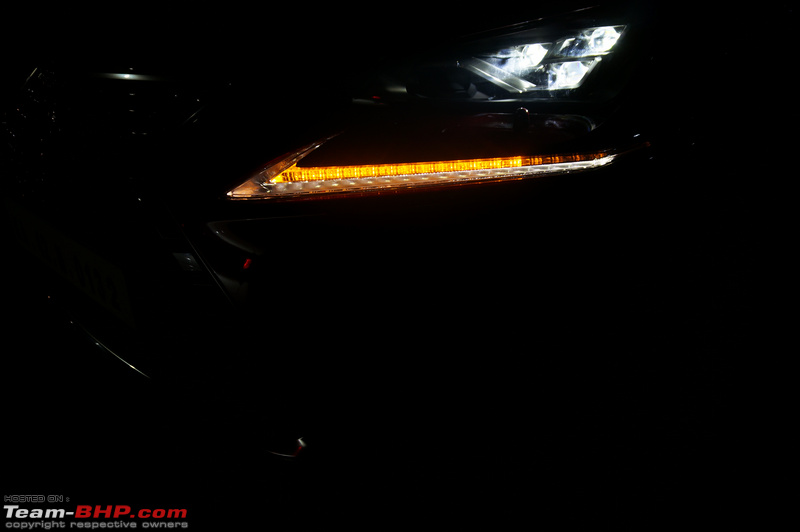
DRLs are powerful even under bright sunlight. At night, they dim a bit when the headlights are on:

Luxury trim gets a grille with slats finished in piano black and surrounded in chrome:
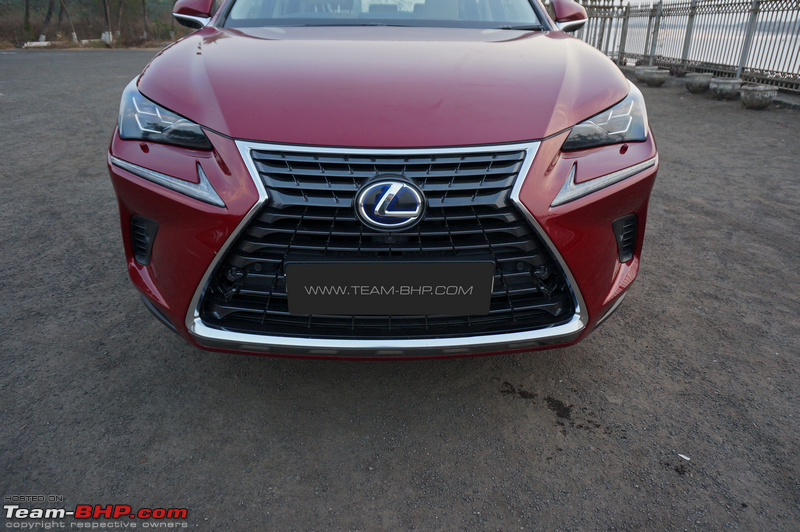
F-Sport trim gets the funky grille with a weave pattern. Instead of shiny chrome, the grille is surrounded by blackened chrome. The side vents are also larger with the same weave pattern. There's a front lip spoiler finished in silver for a sportier look:

Front camera is tucked away just below the Lexus logo. It is part of the 360-degree camera system:

Only the F-Sport gets a badge on both the front fenders:

10-spoke bronze and black alloys on the Luxury variant shod with 225/60 R18 Bridgestone Dueler H/L tyres:

F-Sport gets silver and black alloys in a different design. Both variants get the same tyres:
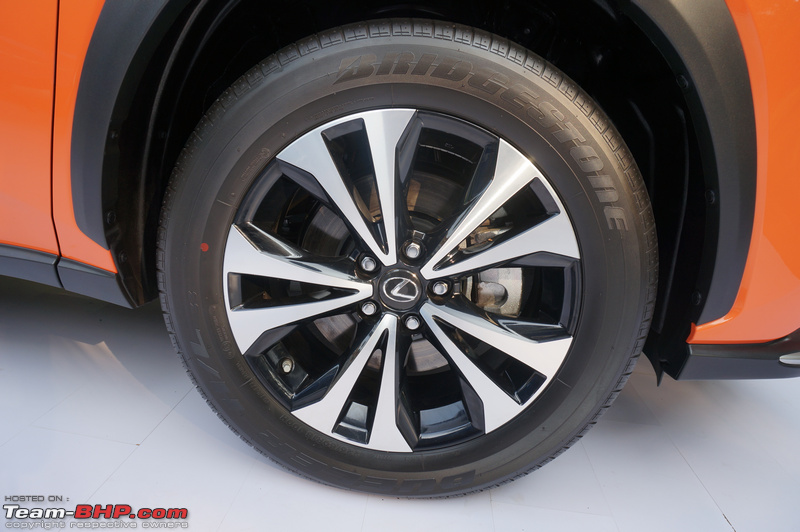
Body coloured ORVM gets integrated turn signals with a chrome accent. The F-Sport variant gets a black ORVM with the same chrome accent:

Each ORVM gets a downward facing camera. It is a part of the 360-degree camera system and helps to show the kerb while parking:
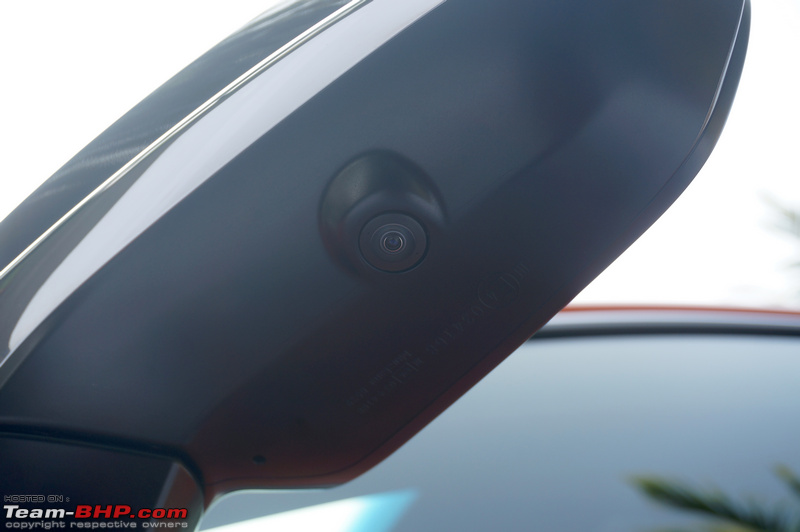
Sleek door handles. The indent at the front is for the keyless entry system, which locks the car. Usually most cars have one towards the back of the handle. All doors get this feature:

Walk up to the car at night with the key in your pocket and the ambient lights as well as the puddle lamps on the door handles light up:
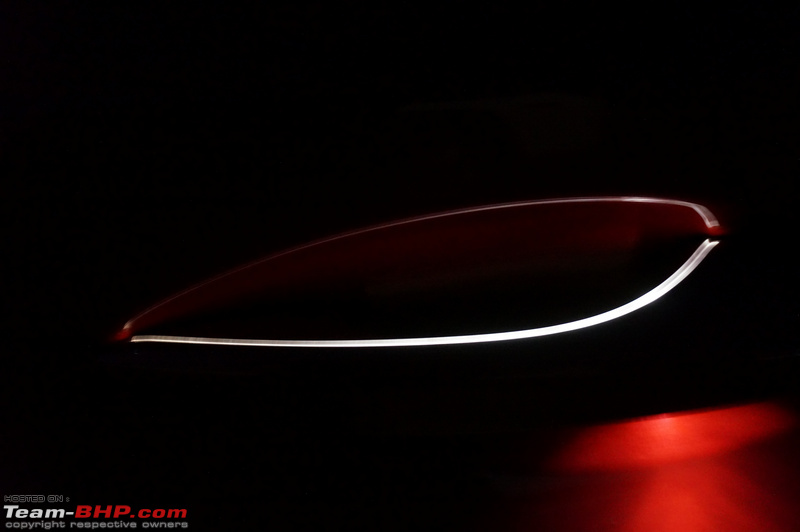
Roofline slopes down towards the rear where it integrates with the spoiler. The quarter glass on the C-pillar gives the NX reasonable glass area:

Huge panoramic glass roof almost spans the entire cabin length...but it is fixed i.e. it doesn't open like a sunroof. Falling objects such as coconuts might be a very expensive affair to fix. Shark fin antenna is located in the back:

Sharply designed LED tail lamps have a piano black shroud around them; looks funky:
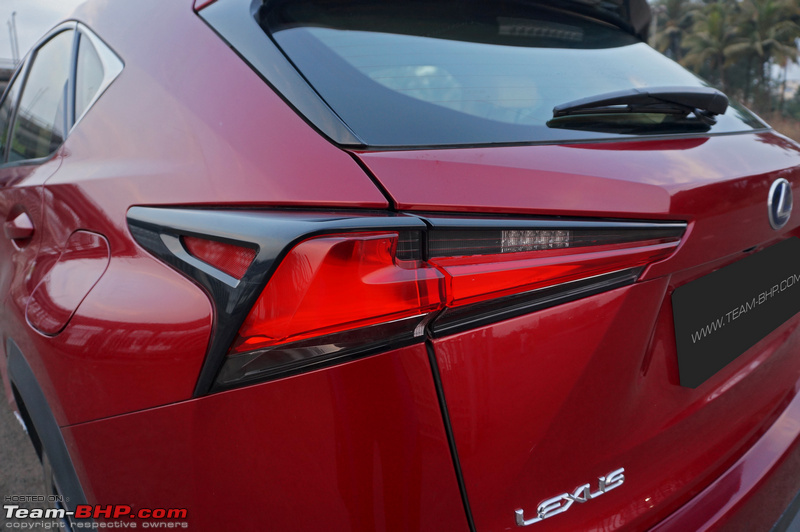
Lexus on the left and the model name on the right. No other badges. The F-Sport gets a piano black insert on the edges of the bumper (just below the reflector and fake vent):

Luxury variant on the other hand gets a chrome strip on the bumper corners. The design of the vent matches the one at the front:

The rear spoiler tapers down at the sides, wrapping around the windshield. The windshield itself is small and heavily raked affecting rearward visibility:

The blue hue surrounding the badge signifies that it is an electric / hybrid model. Rear camera sits above the number plate housing:

Interiors
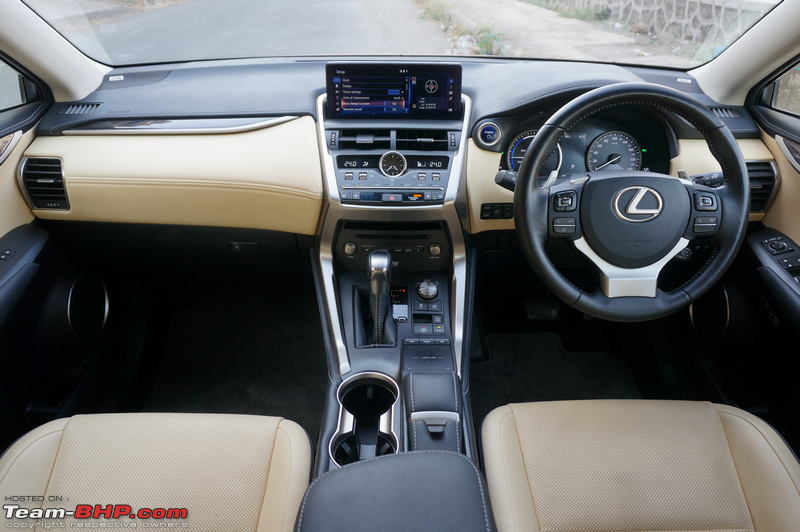
The NX 300h gets a host of customisable options for the interiors that include the upholstery, roof lining and dashboard trim colour, depending on the F-Sport or Luxury variants. Luxury variant gets beige roof lining for all colour schemes. You can choose between black, rose red, tan brown and off white for the seats with an all black dashboard. In addition to that, you can get a white dashboard with black, off white or beige seats. Depending on the colour combo selected, there are dark wood accents on the doors and dash or there's a very nice looking bamboo finish. The F-Sport on the other hand gets all black roof lining as well as a black dash, but you can choose between all black, black / white, black / red and black / yellow for the seats. Instead of wood accents, you get aluminum accents on the doors and dash. The fit and finish is excellent along with the quality of materials. Lexus offers a total of 11 different combinations for the interiors. This is a welcome change in India where we are usually left to the mercy of manufacturers to decide on the interior colour scheme.
The centre of the dash houses a large 10.3-inch multimedia screen. The infotainment system has integrated navigation and can be operated via a touchpad. A Mark Levinson audio system with 14 Speakers is standard. However, it misses out on Android Auto and Apple CarPlay integration!! Sucks. Toyota and Lexus don't have Android Auto and Apple Carplay in any of their vehicles. The 2019 models are expected to get Apple Carplay, but Toyota is skipping Android Auto. The SUV comes with a three-spoke, multi-functional steering wheel and a twin-pod instrument cluster. It has reclining rear seats and a kick-sensor activated powered tailgate in addition to a dual-zone climate control system and 8-way adjustable memory seats for the driver.
Open the door to enter the car and you will see the driver's seat move back + the steering wheel tilt up for easy ingress into the car. Once the start button is pressed, the seat moves back into the set position:

The three spoke leather wrapped steering wheel is heated (useless for India). It's on the smaller side and is simple, but nice to hold:
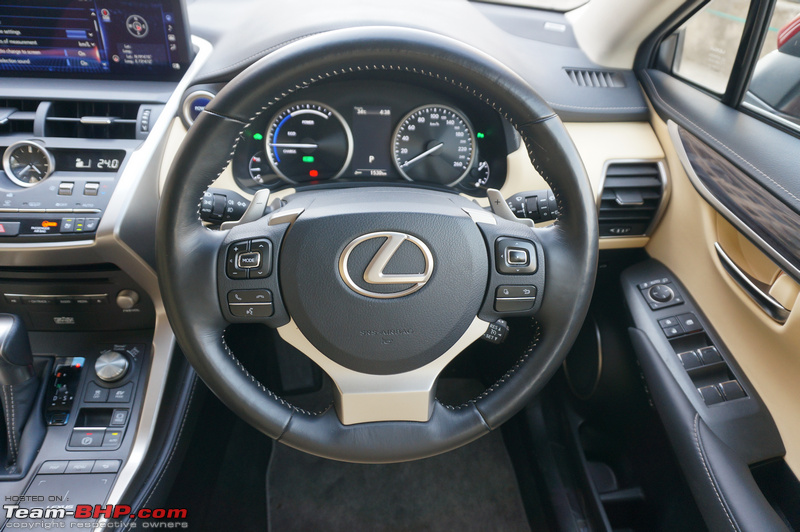
Buttons on the left of the steering wheel are for the media controls and the ones on the right are to navigate through the MID settings. The buttons feel premium to use and provide good feedback:

Paddle shifters are made from brushed aluminium - upshift on the right and downshift on the left. Quality as expected is superb and they feel tactile to use:

Instrument cluster consists of three LCD screens. Unlike the Audi and Volvo, this is not like a virtual display. The screen on the left works as the tacho in normal mode. In EV / ECO mode, it shows the battery status. The screen on the right is the speedometer. They are not full round LCD screens with traditional warning lights below. Third LCD is the central MID. Traditional temp and fuel gauges are always nice to see:
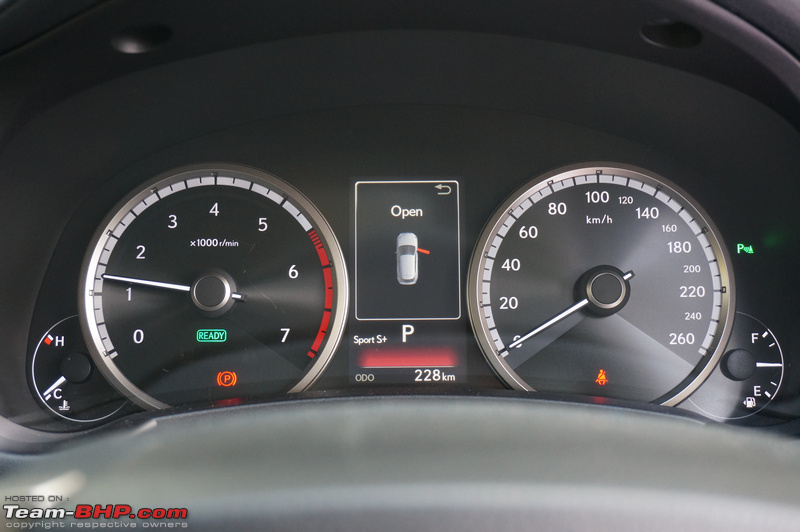
In EV / Eco mode:

This is how the console looks when starting up. The colour MID resolution is sharp with details clearly visible:

You know that Lexus is made for the Americans when the indicators are on the left and wipers on the right - this in a RHD Japanese car :D. The stalks are of good quality, albeit nothing special in design:
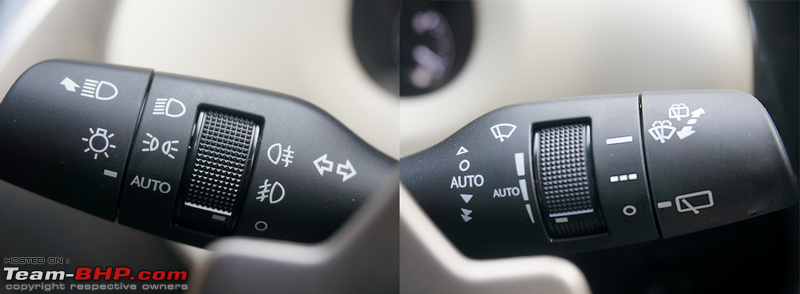
Centre console consists of a 10.3" non touchscreen display at the top. Air vents below are small but effective. Analogue clock between the climate control LCD adds a classy touch. The brushed aluminum finish on the sides of the console is finished well: Way too many buttons though - looks awfully cluttered:

There are buttons just behind the steering wheel. Ones on the left are for the head-up display:

There are many more buttons on the right hand side of the steering wheel for the trip reset, illumination intensity of the instrument cluster & folding of rear seats electrically (only on the Luxury variant). To the far right, there are buttons for the heated steering, parking cameras and boot release. What's really disappointing is the amount of blank switches here:

The bonnet release lever looks like it's from the common Toyota parts bin:

Gear lever is not in the centre, but closer to the passenger than the driver (more LHD than RHD). To the right of the gear lever is the drive mode selector knob which can be used to change between Eco, Normal, Sport and Sport+ modes. Below the mode selector are 2 buttons, one to switch the NX to EV mode only (provided the batteries have enough juice) and the second button for switching traction control off. There's also the electric parking brake with
auto hold: 
Typical P-R-N-D and S AT gear format. The gear slots in easily and it is not possible to accidentally move it. If you keep the car in neutral for a while, the MID prompts you to shift the lever into P for safety:

Infotainment system is controlled using this touchpad. While the touchpad is responsive and gives vibration-feedback on confirmation of a press, it is not very intuitive to use. BMW's i-Drive system still remains one of the best here. Two cup-holders on the left with a padded wrist rest on the right. The lower half opens up by pulling up the tab…

… to reveal a vanity mirror underneath! This part is removable, below which there is a small storage compartment with soft lining:
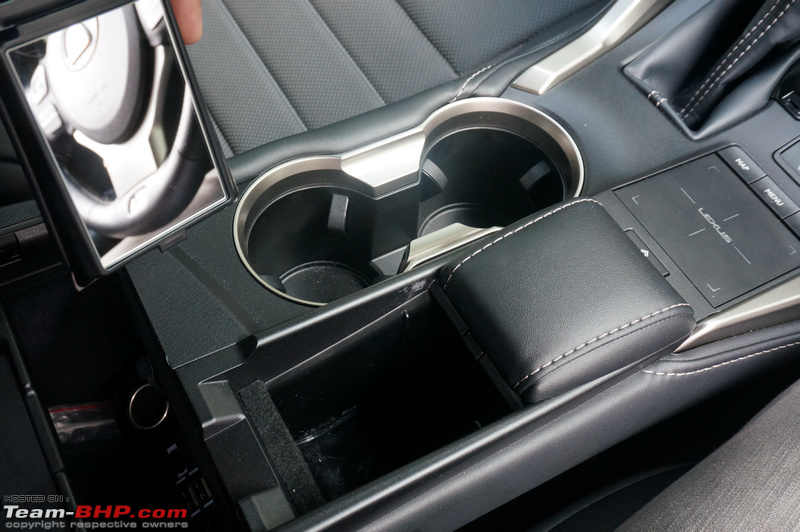
Armrest can be adjusted for height as well as reach (fore and aft):

It opens up to reveal a large felt-lined storage space. iPhone 5S kept here for scale:

2 USB ports, AUX input and a 12V socket are located in the armrest:
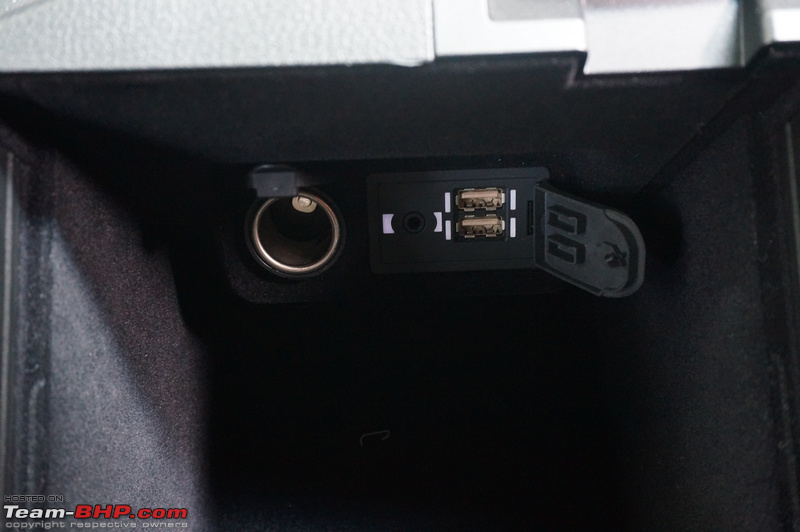
Also has a tray that supports QI wireless charging. Neat:

Dual zone climate control at the front. Knurled rotary switches to adjust temperature, blower speeds and direction feel fantastic. Other A/C control buttons are on the smaller side. Front driver and passenger seats can be heated or cooled:

Infotainment screen supports split screen functionality. While a touchscreen would have been welcome, the touchpad which controls the infotainment system seems ok once you get used to it. But having said that, doing any adjustments on the move is not easy. It seems to have an anti-reflective coating to help with visibility during the day:

The energy monitor shows the power source (IC engine or electric) being used and the direction of flow of energy. The battery state of charge is also seen:

360-degree camera in action – it shows all the 4 corners of the car on the left side of the screen, along with the reversing camera on the right with adaptive guidelines:

Front doors open wide in a 3-stage action. Soft touch materials in most places on the door pads. The door pockets are long, but too shallow to hold bottles:

Power window controls get a touch of chrome around the buttons:

Lexus branding on the door sills. The sill area is not wide, making it easy to get in. There should have been a scuff plate to prevent the painted area from getting scratched by shoes:

Front seats are well-contoured and offer good side bolstering. Lumbar support is present, albeit 2 way vs 4 way i.e. lateral only and not up / down. Seats are all electric and you get 3 memory settings as well. Seen here are the black seats of the F-Sport variant:

LED map lights at the front are touch operated!! Touch them anywhere on the transparent area to turn the lights on or off. No sunroof buttons here as it's a fixed glass roof. However, you can close or open the blinds for the glass roof:

F-Sport gets aluminum finish on the pedals. The pedals are large and ergonomic. Footwell area is sufficient for those with large shoe sizes:
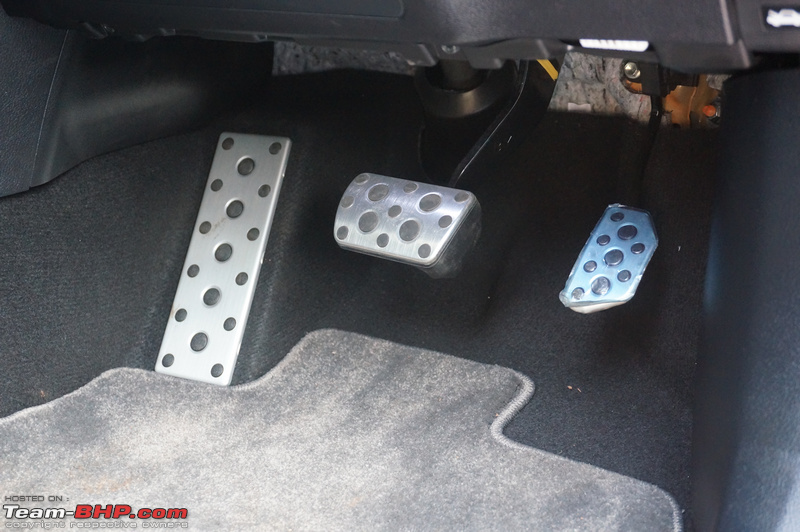
ORVMs offer sufficient visibility. The portion beyond the dotted line on the edge is more convex than the left, allowing for a wider angle of visibility:
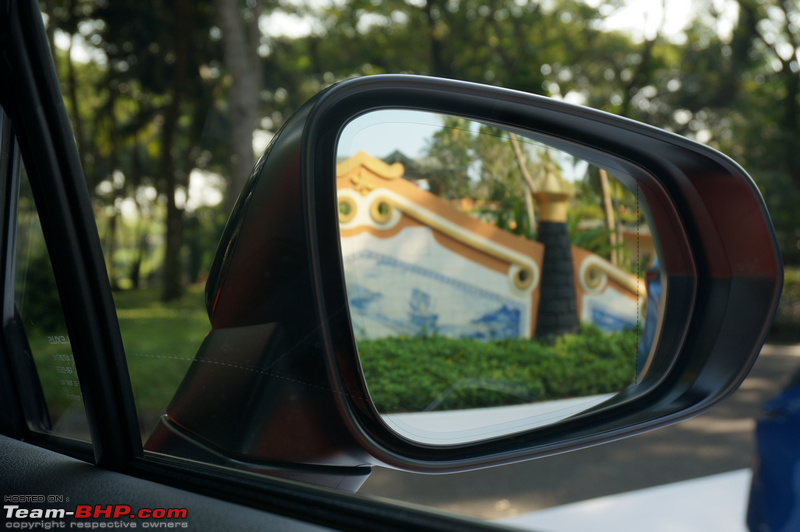
Rear door gets the same design as the front. It houses one speaker and a tweeter. A single bottle holder is located at the bottom:
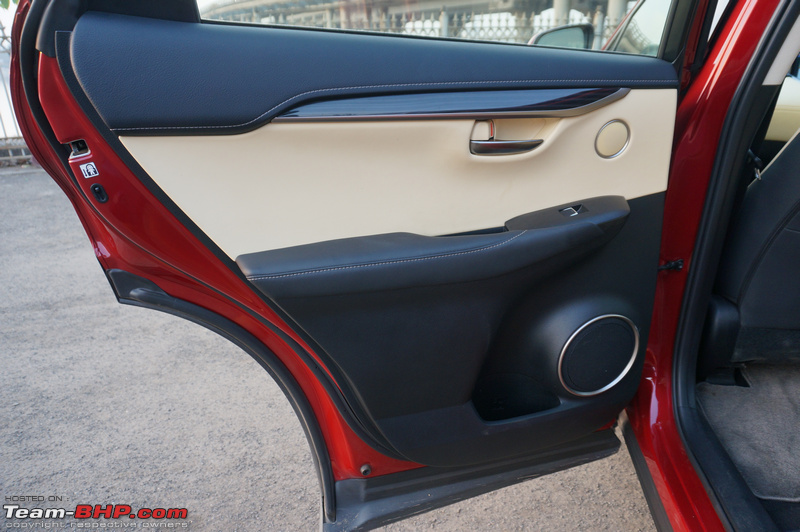
Leg space at the back is adequate and the doors open sufficiently wide for comfortable ingress / egress. Also notice the maximum and minimum recline angles of the seatback. The seatback reclining function is controlled electronically using buttons below the seat:
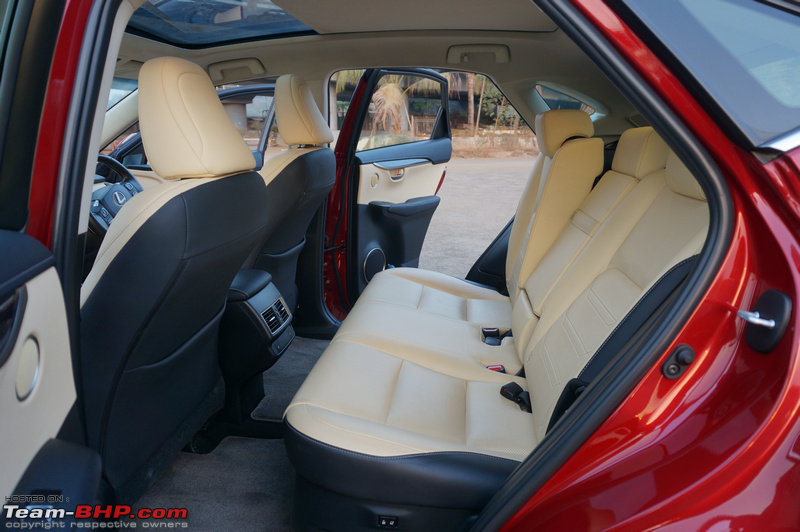
Rear seats are comfortable for two, not three. Back seat leg space is less than the X3, but the backrest angle is way better. The seats fold in a 60:40 split:
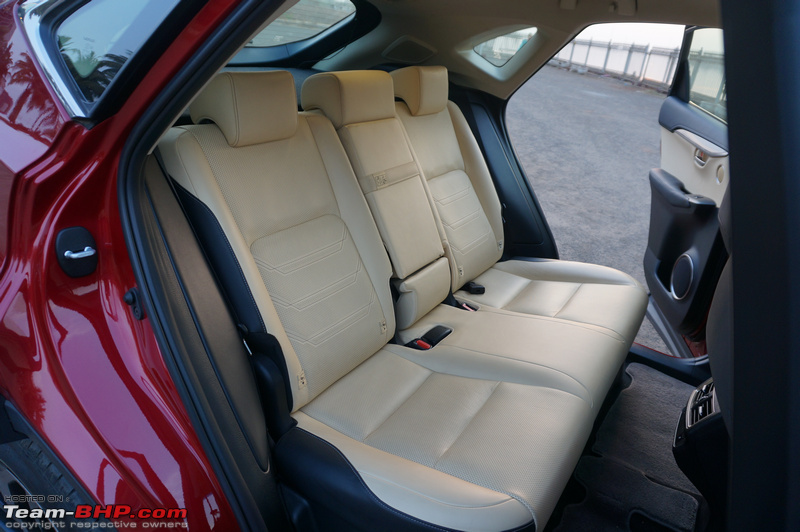
Rear A/C vents along with the heated seat controls (Luxury variant); rather silly not to have cooled rear seats instead:

Rear boot space is severely compromised due to the hybrid battery pack as well as the full sized spare:

The regular car battery is on the left. The display vehicle had a trickle charger connected to it:
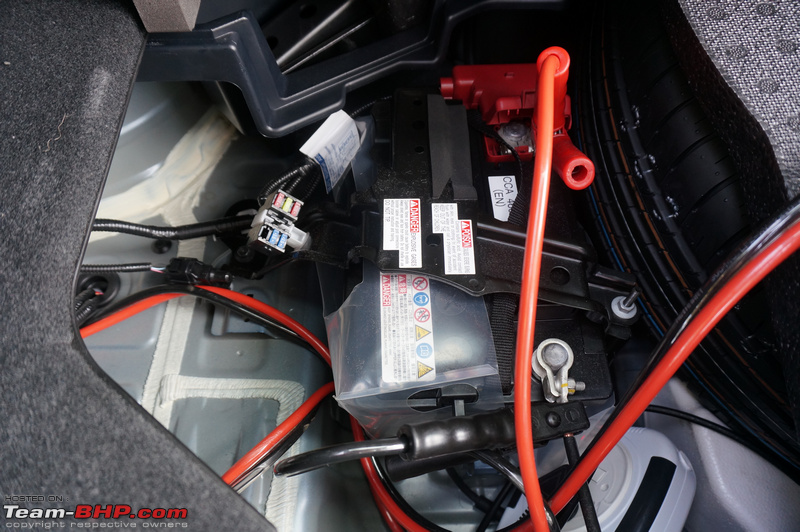
Driving the 2.5-litre Hybrid

The NX gets a 2.5-litre (codenamed 2AR-FXE) 4-cylinder Atkinson cycle petrol engine coupled with two electric motors. The internal combustion engine and Hybrid system are similar to the Camry + ES 300h but the NX gets an additional electric motor for AWD capability. The petrol engine puts out 153 BHP @ 5,700 rpm and 210 Nm @ 4,200-4,400 rpm. The combined output of the hybrid system is 194 BHP. This is a tad lower than the ES and Camry's power output. I'm guessing this was done due to the additional complexity of the second electric motor for the AWD system? The AWD system uses the petrol engine along with an electric motor for driving the front wheels, while a rear electric motor drives the back wheels only when needed. Further, a motor-generator is connected to the engine that charges the batteries. While on paper it does match up to the competition, the Lexus with its hybrid powertrain is unique to drive. If you are an enthusiastic driver, you will be disappointed. But for relaxed driving, this car is brilliant.
The only other petrol electric hybrid I've driven extensively (1,500 km) is the BMW i8. Get inside, press the start button with your foot on the brake and nothing happens, except for a ‘Ready’ sign being displayed in the console. Step on the accelerator and the car takes off silently – it’s a refreshing experience as the car is super silent in electric mode. The system is very clever and thanks to seriously good insulation, you will be hard pressed to tell when the internal combustion engine starts up, especially while driving in a relaxed manner. It's only when you floor the throttle that the petrol engine wakes up with full force to provide additional power to the wheels. The seamless nature of power from two different sources is pretty neat. A CVT transmission is connected to the front wheels. From a smoothness point of view, the CVT box is unmatched and most owners will appreciate this AT. However, with the accelerator buried to the floor, you will hear a strained noise from the gearbox; many times, there is a lot more noise than performance in kickdown mode.
Under city conditions, the instant availability of power, thanks to the electric motors results in immediate response to throttle input. For pottering around town, the NX has enough grunt in Eco and Normal drive modes. It delivers a smooth experience till you start demanding more. While Eco mode was sufficient to move around at a comfortable pace, there was an evident lack of power as well as a lazier throttle response. Further, in Eco mode, the air conditioning is restricted to improve the fuel economy.
There is also an EV mode where the NX uses just the electric motor to move around. The top speed as well as range in this mode is limited. EV mode also automatically disengages after 50 km/h and the petrol engine is eager to kick in when you press the accelerator pedal anything more than ~15%. Once the batteries lose charge in EV mode, the petrol engine turns on to charge the batteries as a generator. The EV mode is a cool party trick as the NX moves with eerie silence in this mode. Also, it's ideal for short runs to drop kids to school or run nearby errands.
Normal mode is the middle ground. It doesn’t curb the air con or reduce throttle response like in Eco mode. In both Eco and Normal modes, once you get to a constant speed (cruising), we noticed that the batteries took over. Even at speeds above 60 km/h, the petrol engine would turn off, the rpm would be zero and the car would maintain its speed with the electric motor. It was only when the batteries lost charge that the motor would turn on to charge them for a while, or when you press the accelerator to increase the speed.
The NX is a vehicle I started driving with no expectations, and it didn't really disappoint. Thanks to the electric motors, it has instant torque and feels very peppy off the line. Even overtaking moves are easily done since the Lexus responds to the A-pedal instantly. Now, don't expect Tesla kind of acceleration, but it feels akin to a responsive naturally aspirated engine.
All this works well for city speeds, and driving in traffic, but it's when you take it out on the open roads and decide to drive it enthusiastically that the NX starts showing you it's boring side. Press the throttle all the way in, and you hear the motor revving between 4,000-5,000 rpm. The Atkinson cycle motor doesn't like being revved and the redline is at a conservative 5,500 rpm! It's worth noting that the motor is very audible at these engine speeds and sounds like it doesn't want to be pushed. Speed does increase in a linear manner, and while it's not really fast, it's not a slouch either.
Out on the open road, it's best to use the Sport mode. Here, the shift points are sharpened; throttle response is better and the steering wheel weighs up. Most BHPians will prefer this mode, since it unleashes all the car’s available horses. The petrol engine is much more eager in Sport mode. Paddle shifts are useful to prepare the car for overtaking. The NX is heavy at ~1900 kg, and you feel the weight when making quick overtaking manoeuvres. Kickdown response times to a lower gear is at around 1-1.5 seconds after you floor the throttle. Despite having paddles to change the gears (steps of the CVT), the constant drone from the auto box is heard as the gearbox holds the revs at 4,500 rpm for extended periods.
Despite having an all-wheel-drive system, we found that most of the times, the NX was in front wheel drive mode. It's only when the surface is really slippery or when you start from a standstill a little aggressively that that the rear motor engages.
What I didn't like about the drive was the CVT transmission. It has a proper rubber-band effect that is extremely irritating. In fact, with many manufacturers making CVTs feel more like conventional transmissions, I was surprised with the lazy way this behaved. Blackwasp, who was sitting with me, joked that it felt like an Activa...and I couldn't disagree. That being said, you don't notice the weaknesses of the gearbox until you start to push the vehicle. What I found surprising is that the gear display in the vehicle was showing D1, D2 even when the petrol engine was off.
Ride and Handling
The NX 300h gets MacPherson struts up front and a double wishbone suspension at the back. It also gets adaptive variable suspension, which constantly adjusts the dampers to provide a good ride. However, at low speeds, the ride is on the stiffer side. One can feel all the bumps the NX goes over at slow speeds. The car rides on 225/60 R18 tyres and the large sidewall probably helps improve ride a little. With 19 inchers, the NX would be uncomfortable. There is some vertical movement felt at high speeds, but nothing that is uncomfortable. It is best to drive the car sedately.
The dynamics were nicer than we expected once we left the city. At higher speeds, body roll is well controlled. As the speed builds up, the suspension settles down and passengers will feel more comfortable. I think the word to describe this suspension would be pliant. I drove the car at a brisk pace and the tyres provided sufficient grip, and held its line around corners, giving me confidence. Despite the power being available to all the wheels, the car mostly behaves like a FWD and tends to understeer. Stability is rock solid and you won’t feel anything unsettling. The NX 300h feels sure-footed at speed – dynamically, it is set up well.
The electric power steering weighs up as you build up speed, but not as much as enthusiasts would like. Most of us will still find it to be on the lighter side. The steering feedback isn't great either, although it is better than the Audis'. On the positive side, the steering is precise and sharp. You can definitely notice how the steering weighs up in the different drive modes.
The NX has a ground clearance rating of 185 mm (laden). This is more than enough for any kind of driving condition. Braking duties are handled by disc brakes all around as well as regenerative braking. They are spongy, yet powerful. The brake feedback is a bit vague, but consistent with most of the hybrid vehicles due to the regenerative braking. Light braking is handled by the regenerative braking system and it's only when you brake a little hard do the disc brakes assist the braking.
Half of the bonnet is covered by an insulation sheet. In the electric mode, the car runs silently and it is only when the petrol engine kicks in that you realise there is one in the car:

Bonnet is held up by these struts on either side:

The 2.5-litre petrol engine runs on the efficient Atkinson cycle. In ECO mode, it turns on only to charge the batteries (no power to the wheels from the engine) or when the accelerator is pressed hard:

The ECU is located on the right side, near one of the relay and fuse boxes…

…while the other fuse box is on the left side:

Separate coolant for the invertor. Similar arrangement is used in the ES sedan as well as the Camry hybrid:

Firewall gets a thick insulation sheet:

The head-up display allows the driver to keep his eyes on the road:

It can also be configured to display the G levels, hybrid powertrain mode or just the speed and current gear:

In Sport mode, the MID gets a red background and the tachometer is displayed on the left dial:

Other Points
• Lexus currently has dealers in Delhi, Gurgaon, Mumbai and Bangalore. Service centres are at Delhi, Gurgaon, Mumbai, Bangalore, Hyderabad, Chandigarh, Chennai and Kochi.
• While there are 8 service corners - dedicated service bays for Lexus in existing Toyota workshops, a salesperson at Lexus told us that for servicing, your Lexus in other cities will be just as easy. The company will fly down technicians to the car who take it to the nearest Toyota workshop for the needful. Lexus has a reputation for pampering its customers.
• F-Sport gets a sound-generator that sends out engine noise from the speakers. It is supposed to make the car feel sporty?! Lexus calls it
Acoustic Sound Control.
Missing doorsills at the back points to unnecessary cost-cutting:

Powered tailgate gets a button to open or close it. Press the lock button and then close the tailgate when you are done:

Vents that take air from the cabin to cool the hybrid batteries at the back. Also notice the manual recline adjustment handle on the F-Sport variant for the rear seat (Luxury variant gets electrically reclining seats):

14-speaker Mark Levinson surround sound system comes as standard:
 Disclaimer: Lexus invited Team-BHP for the NX300h test-drive. They covered all the travel expenses for this driving event.
Disclaimer: Lexus invited Team-BHP for the NX300h test-drive. They covered all the travel expenses for this driving event.
Thread moved from the Assembly Line to the Test-Drives Section. Thanks for sharing!
Brilliant writeup!! Though polarizing design wise, i truly feel its a welcome change in the sea of Audis/Beemers/Mercs.
The attention to detail is always a highlight in all Tbhp writeups.
Brilliant review.
I really don't see volume sales in this car compared to the German competitors as they offer so much more. Still a niche market is a niche market.
Lexus does got a polarizing design language and I'm on the far end of the like spectrum.
P:S: When will the 5 series G30 review be up, its almost forgotten.
Excellent write up and thank you very much for sharing this. Not sure who would prefer this car over the European counterparts. It sure does look funky and nothing of a kind in India and the hybrid system in this segment is a welcome change.
Quote:
Originally Posted by Akshay1234
(Post 4397763)
Other Points
Gear lever is not in the centre, but closer to the passenger than the driver (more LHD than RHD). To the right of the gear lever is the drive mode selector knob which can be used to change between Eco, Normal, Sport and Sport+ modes. Below the mode selector are 2 buttons, one to switch the NX to EV mode only (provided the batteries have enough juice) and the second button for switching traction control off. There's also the electric parking brake with auto hold:
|
I felt this to be more of ergonomics than the LHD configuration. So many controls being there, I guess Lexus would've purposely kept the gear level on the left to provide easy access to these controls. Also, this being an automatic with paddle shifters in place not many would reach for the gear selector while driving. IMO.
Although the design of the NX will be a controversial matter, I think it offers a refreshing change in its segment. The NX is pretty common in Dubai and always manages to grab my attention (in a good way). With its futuristic looks, brilliant quality, decent pricing and unmatched combination of after sales & reliability; Lexus seems to have a winner in its hands!
Great review. Less over priced than other Lexuses in India - though pricing at the same level as the new X3 20d is still high as the NX 300 h sells for USD 4000 (viz 10%) less than the X3 30i in the USA. The boot looks really tiny - not sure if it is a function of the picture angle, would be good if someone can post a picture with some bags in it for reference, and compare with a GLC (with the spare in the boot). Agree fully that hybrids make immense sense in urban India, even if they are not great from an enthusiast’s perspective. But there clearly will be a segment for whom this car will make immense sense. Hope that Trump turns his attention to the criminally high tariffs on imported cars in India and forces India to reduce tariffs to a more sensible level, which will make Lexuses far more affordable in India.
Excellent review as always, Akshay Sir.
Back in Dubai, the NX is a very popular car primarily due to it’s price and design. Dad’s cousin sister owns a NX 300 F Sport back in Dubai and I found the headroom in the 2nd row to be less than adequate. However, the legroom is more than adequate and the black interiors also give a sporty feel.
Attaching a picture of the black interiors in the F Sport edition:
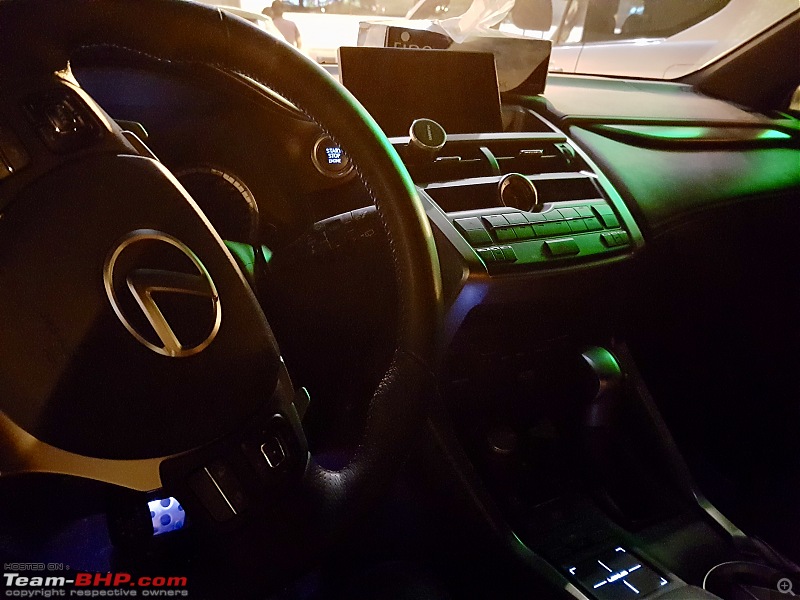
With the current pricing, Lexus has a winner in their hands. For a buyer who doesn’t want to go in for the German trio, the Lexus will be a great alternative, with cheaper maintenance and reliability.
Thank you for a first class review and writing to comprehensive on the hybrid system. that orange candy colour is quite something. Will be rating it a well deserved 5 stars.
Quote:
Originally Posted by Akshay1234
(Post 4397756)
Normal mode is the middle ground. It doesn’t curb the air con or reduce throttle response like in Eco mode. In both Eco and Normal modes, once you get to a constant speed (cruising), we noticed that the batteries took over. Even at speeds above 60 km/h, the petrol engine would turn off, the rpm would be zero and the car would maintain its speed with the electric motor. It was only when the batteries lost charge that the motor would turn on to charge them for a while, or when you press the accelerator to increase the speed
|
The switch constantly from battery to ICE to motor charging the battery is instantaneously controlled by the computer with superb smoothness.
Quote:
Under city conditions, the instant availability of power, thanks to the electric motors results in immediate response to throttle input. For pottering around town, the NX has enough grunt in Eco and Normal drive modes. It delivers a smooth experience till you start demanding more. While Eco mode was sufficient to move around at a comfortable pace, there was an evident lack of power as well as a lazier throttle response. Further, in Eco mode, the air conditioning is restricted to improve the fuel economy.Out on the open road, it's best to use the Sport mode. Here, the shift points are sharpened; throttle response is better and the steering wheel weighs up. Most BHPians will prefer this mode, since it unleashes all the car’s available horses. The petrol engine is much more eager in Sport mode. Paddle shifts are useful to prepare the car for overtaking. The NX is heavy at ~1900 kg, and you feel the weight when making quick overtaking manoeuvres. Kickdown response times to a lower gear is at around 1-1.5 seconds after you floor the throttle. Despite having paddles to change the gears (steps of the CVT), the constant drone from the auto box is heard as the gearbox holds the revs at 4,500 rpm for extended periods.
|
For the regular driver and even for enthusiast wannabes like me the acceleration even in normal mode is very good and in our cities and most of our highways we would struggle to use even 75% of the power. I test drove the car on NH8 some months ago in Eco mode (what else would you expect from me!) and the usual overtaking was scarcely a challenge. But as I said this is for the ordinary regular driver like me.
Quote:
Braking duties are handled by disc brakes all around as well as regenerative braking. They are spongy, yet powerful. The brake feedback is a bit vague, but consistent with most of the hybrid vehicles due to the regenerative braking. Light braking is handled by the regenerative braking system and it's only when you brake a little hard do the disc brakes assist the braking.
|
After having used the ES300h from the same stable and incidentally carrying the same engine my feedback is that that braking is something our brain and eye-leg co-ordination gets accustomed to. I thought similarly a year back but after 1000 kms I couldn't tell any difference.
Quote:
Originally Posted by Hayek
(Post 4398093)
The boot looks really tiny - not sure if it is a function of the picture angle, would be good if someone can post a picture with some bags in it for reference, and compare with a GLC (with the spare in the boot).
|
The usable boot space is 2X that of an Alto. That's the impression I got during my test drive some months back and general window shopping around.
With a price in the low to mid 50s they are in all likelihood selling this CBU at a loss. But I think the aim is to provide a reasonably priced competitor to its rivals like Q5, X3? and others. Lexus have, I'm told, sold 150 units since the launch 2 months ago - good or bad or so-so I really don't know. As this is their zippy baby Lexus I suspect they have decided to get aggressive. All good for the customer.
Some pics of a NX I saw a couple of weeks ago.
Quote:
Originally Posted by ///RMan
(Post 4399300)
Some pics of a NX I saw a couple of weeks ago.
|
I spotted a red one today here in Bangalore and looked quite rich and stylish. That said road presence is nothing great, a new Fortuner in front the Lexus looked meaty.
| All times are GMT +5.5. The time now is 08:49. | |


















































































